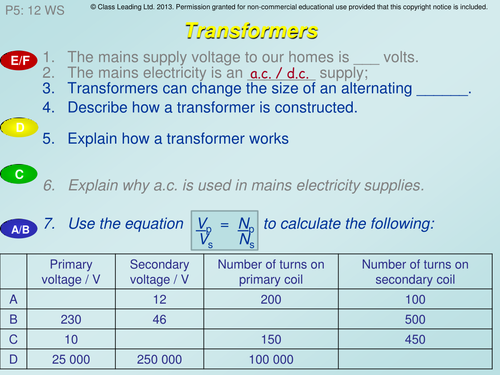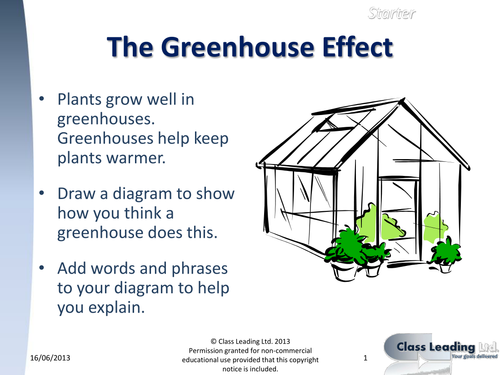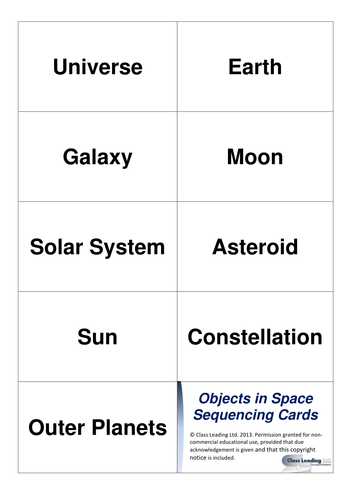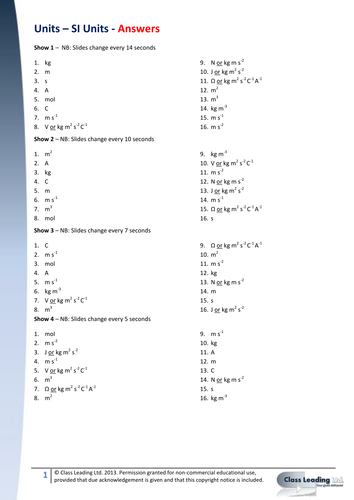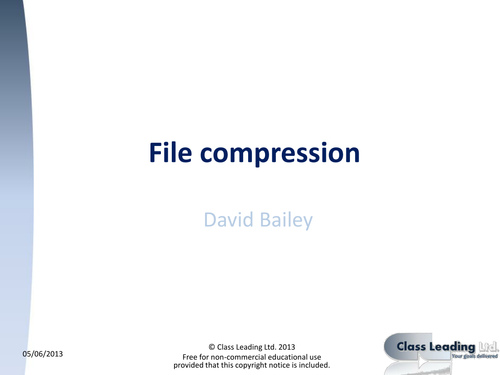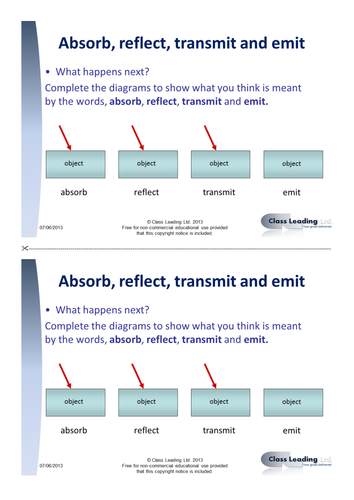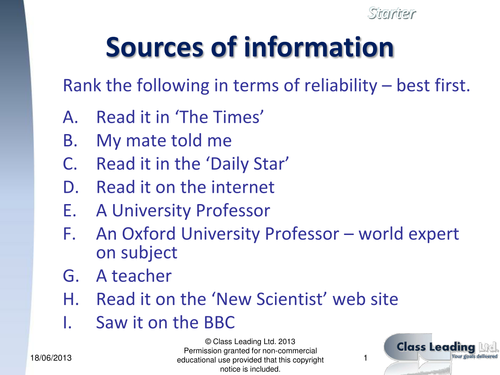314Uploads
262k+Views
194k+Downloads
Physics

Transformers - graded questions
This activity contains a powerpoint with graded questions & answers and matching pupil activity sheets, designed to be used at the end of a lesson and/or the start of the next lesson to review previous learning. The questions are based on the previous OCR 21st Century Science Specification unit P5, although could be used with other exam boards.\nClicking through the show reveals answers one a time. These reduce to A5 easily, the ideal size for most pupils. Please note grades are approximate.

Greenhouse Effect starter - Draw what you think
A simple but effective activity to establish prior knowledge at the start looking at the topic of the Greenhouse effect. Learners can be encouraged to use scientific vocabulary and ideas. It is a great way of finding out how they think a greenhouse works before looking at the atmospheric effect. Works well when working in small groups (e.g. 3) on a large piece of paper. Really helps them to think when they are asked to justify their reasoning.
Right-click then 'save as&' the web link to download the PowerPoint show.

Objects in Space sort cards
Key words: Universe, Galaxy, Solar system, Sun, planet, asteroid, constellation.
This is a sort card activity and powerpoint show to support the task. It gets students thinking about objects in space. The powerpoint show comes in two forms, with or without the word constellation. The addition of the constellation card adds a real opportunity for cognitive conflict and helps iron out a preconception of what a constellation is.
Right click the web links to download the powerpoint shows.

Maths Skills - Units - SI Units Starter
These are a sequence of powerpoint shows designed as an instant engagement task (rolling on screen as learners enter the room for immediate engagement with learning). Learners write down the the SI units for the named quantity. More able learners could provide SI units in terms of fundamental base units. They are essentially the same task (with rearranged slides) but get progressively more demanding (as the changeover of slide gets faster) as the numbers in brackets increase. Start the students with (1) and then as they get faster, use the more demanding versions

P2 Images, compression and file size
Keywords: Image, quality, file size, download time, compression
A series of activities that use a familiar image to get across the relationship between file size and image quality. It also supports learners to consider the effect of compression on image quality. It was intended to use the powerpoint show as a starter and follow it up with the file size worksheet, then the compression worksheet. Originally designed for unit P2 of 21st Century Science. Right click the web link to download the powerpoint show.

Capturing Seasonal Change
This activity is aimed at KS1 learners exploring seasonal change. Due to the nature of seasonal change, the suggested activity is intended to be run over a long period of time (up to one year).

Models of the atom - Comparison
This activity aims to clarify thinking around the models of the atom that scientists use, and why we have more than one model.
A slideshow that compares different models of the atom, the timeline of discovery and summarises the uses of each model.
Key words: Model, Plum-pudding, Rutherford, Dalton, nuclear.

Seismic Waves - graded questions
This activity contains a powerpoint with graded questions & answers and matching pupil activity sheets, designed to be used at the end of a lesson and/or the start of the next lesson to review previous learning. The questions are based on OCR 21st Century Science Specification, although could be used with other exam boards.\nClicking through the show reveals answers one a time. There are two slightly different activity sheets for differentiation - one has key words, the other without. These reduce to A5 easily, the ideal size for most pupils. Please note grades are approximate.

Measuring with oscilloscopes
Keywords: p.d., voltage, potential difference, frequency, time period, time base, measurement
This resource has a powerpoint show with worked examples of how to calculate p.d., frequency etc. using an oscilloscope.
It is supported by graded intended learning outcomes and an independent learning task, which set as home learning has resulted in students being extremely creative.
Right click the web links to download the powerpoint shows.

Draw the meaning - absorb, transmit & reflect
This activity helps learners ‘draw the meaning’ of key words to do with light/radiation. It tests what learners think these words mean and builds an understanding of the concept behind each word. Two slightly different versions - one adds the word ‘emit’. Great as an instant engagement starter (on a sheet on the desk and shown on screen on entry to the room) to a lesson where these ideas will be explored. Also helpful for GCSE students recapping ideas before applying them in a context such as the greenhouse effect. Right click the web links to download the powerpoint shows.

Sources of information - starter
This resource is an was originally designed for instant engagement, to be on display on entry to the room. The students are given a period of time (say 3 minutes) to rank order the sources of information. This works well in groups with mini-whiteboards. The teacher then asks students to indicate whether each source was in the top 3, middle 3 or bottom 3 – e.g. by show of hands. This supports a discussion on reliability and disagreement between groups provides chance for cognitive conflict and students explaining their reasoning. It was originally designed as a starter to LSS activity 3.1

Resistance of LDR & thermistor - graded questions
This activity contains a powerpoint with graded questions & answers and matching pupil activity sheets, designed to be used at the end of a lesson and/or the start of the next lesson to review previous learning. The questions are based on the previous OCR 21st Century Science Specification unit P5, although could be used with other exam boards.\nClicking through the show reveals answers one a time. These reduce to A5 easily, the ideal size for most pupils. Please note grades are approximate.

Average & Instantaneous speed - graded questions
This activity contains a powerpoint with graded questions & answers and matching pupil activity sheets, designed to be used at the end of a lesson and/or the start of the next lesson to review previous learning. The questions are based on the previous OCR 21st Century Science Specification unit P4, although could be used with other exam boards.\nClicking through the show reveals answers one a time. These reduce to A5 easily, the ideal size for most pupils. Please note grades are approximate.

Ohm's Law - graded questions
This activity contains a powerpoint with graded questions & answers and matching pupil activity sheets, designed to be used at the end of a lesson and/or the start of the next lesson to review previous learning. The questions are based on the previous OCR 21st Century Science Specification unit P5, although could be used with other exam boards.\nClicking through the show reveals answers one a time. These reduce to A5 easily, the ideal size for most pupils. Please note grades are approximate.

Resistance - graded questions
This activity contains a powerpoint with graded questions & answers and matching pupil activity sheets, designed to be used at the end of a lesson and/or the start of the next lesson to review previous learning. The questions are based on the previous OCR 21st Century Science Specification unit P5, although could be used with other exam boards.\nClicking through the show reveals answers one a time. These reduce to A5 easily, the ideal size for most pupils. Please note grades are approximate.

Force & Change of momentum - graded questions
This activity contains a powerpoint with graded questions & answers and matching pupil activity sheets, designed to be used at the end of a lesson and/or the start of the next lesson to review previous learning. The questions are based on the previous OCR 21st Century Science Specification unit P4, although could be used with other exam boards.\nClicking through the show reveals answers one a time. These reduce to A5 easily, the ideal size for most pupils. Please note grades are approximate.

Experiment: UV and washing powder
In this video, which is aimed at KS4 pupils, washing powder is shown under an ultraviolet lamp. This shows the fluorescence from the washing powder as the UV light is absorbed and visible light is emitted from the powder, making it appear much brighter than the washing powder would be if it was simply reflecting the light.
This resource is part of a sequence with the following three other resources:
EM spectrum grid https://www.tes.com/teaching-resource/resource-6341301
EM spectrum sort cards https://www.tes.com/teaching-resource/resource-6341302
IR remote control https://www.tes.com/teaching-resource/resource-12952897
This resource

Experiment - melting ice & freezing wax
In this video, which is aimed at KS3 pupils, a video is shown with changes of state of matter for ice and wax.
The melting ice takes place on a two surfaces, a conductive surface (aluminium pan) and and an insulating surface (wooden chopping board). The video shows how the time of melting differs for each surface.
The experiment also shows wax freezing on the same two surfaces.
Pupils can compare the times and suggest explanations as to why the times differ. The video includes prompts to support their thinking.

Experiment: Making a fruit 'battery'
In this video, which is aimed at KS3/4 pupils, a fruit ‘battery’ is shown. The ‘battery’ has been made with different pairs of metals for the electrodes. Readings are shown in the video for the potential difference (voltage) across the electrodes for each pair. Pupils can then consider the connection between reactivity of the metals and the results of the experiment.

Experiment: Stretching a rubber band
This is a video aimed at pupils in KS3/4 that shows an experiment of a rubber band being stretched. The stretching happens when masses are added to the end of the band.
There is an introduction the experiment, which aims to help pupils understand the most important ideas.
After each mass is added the rubber band, the video zooms in on the scale to allow pupils to read this.
This can form the basis of a graphing activity to find the relationship between the masses added and the extension of the rubber band. Unlike the linear relationship of the spring, there are some differences in the way the band extends, particularly towards the start and end of the experiment.
There is a PowerPoint slideshow to help focus the activity if used in a classroom.
This resource forms part of a sequence with two other resources:
https://www.tes.com/teaching-resource/experiment-measuring-the-weight-of-masses-12952546
https://www.tes.com/teaching-resource/experiment-stretching-a-metal-spring-12952559
This resource

